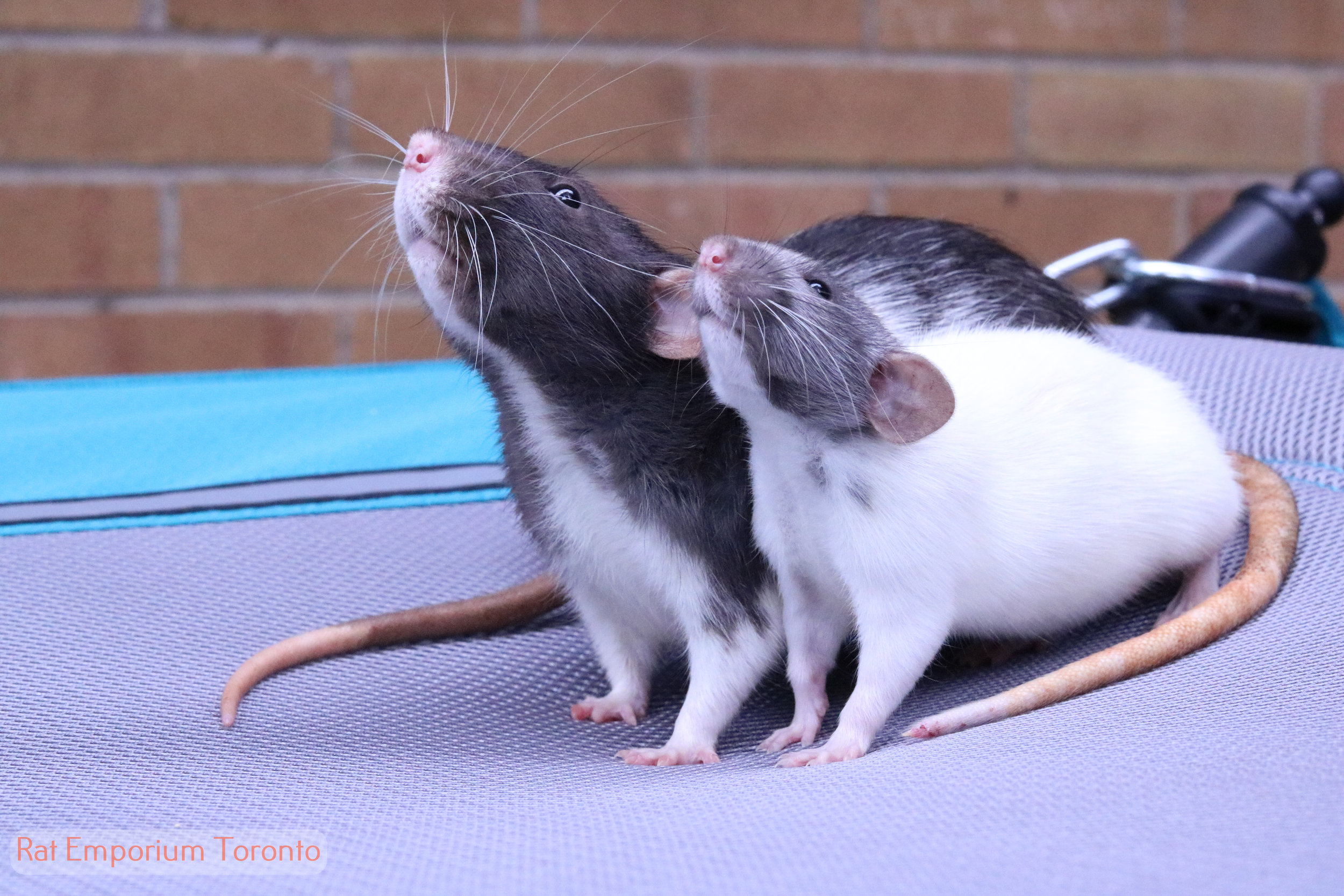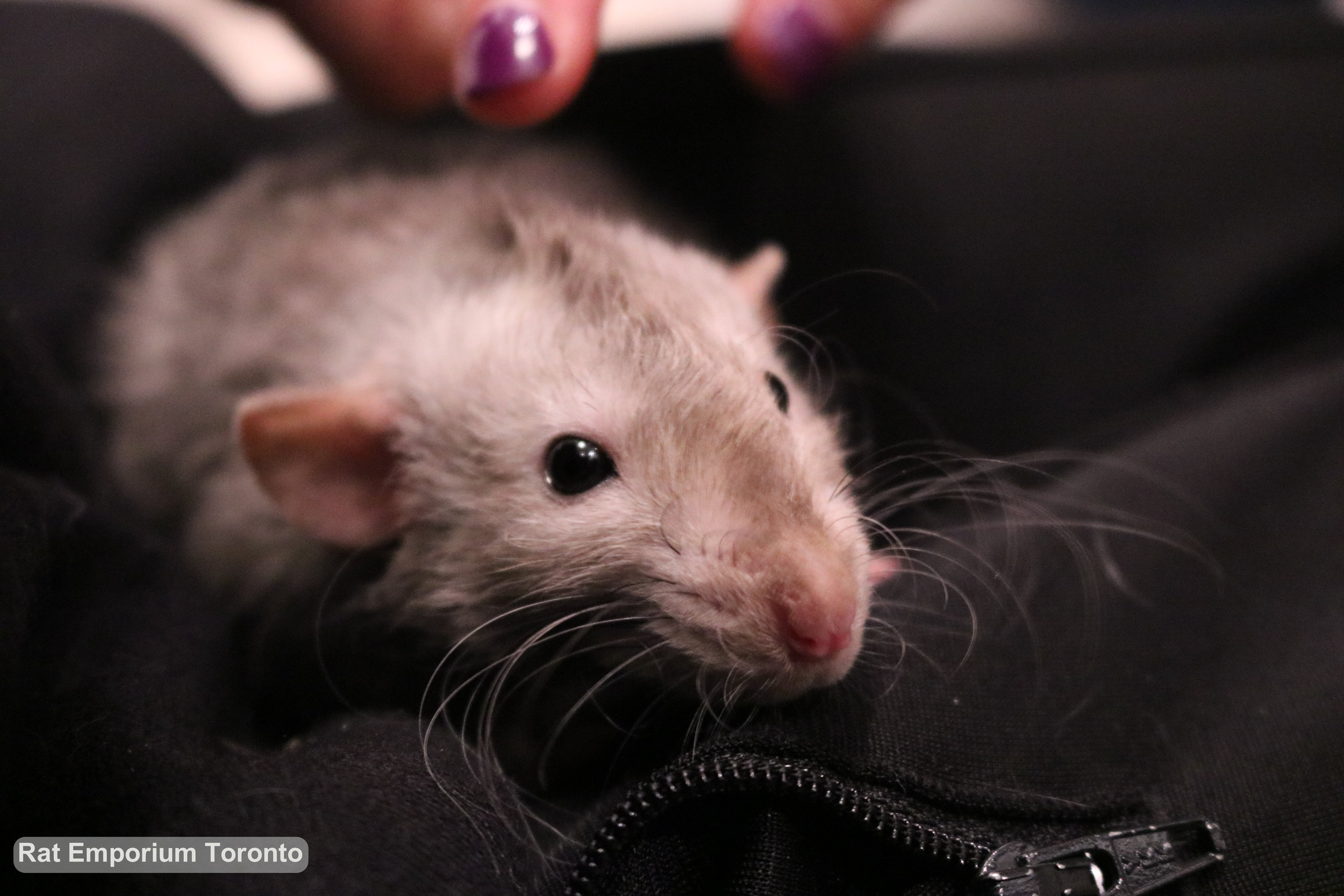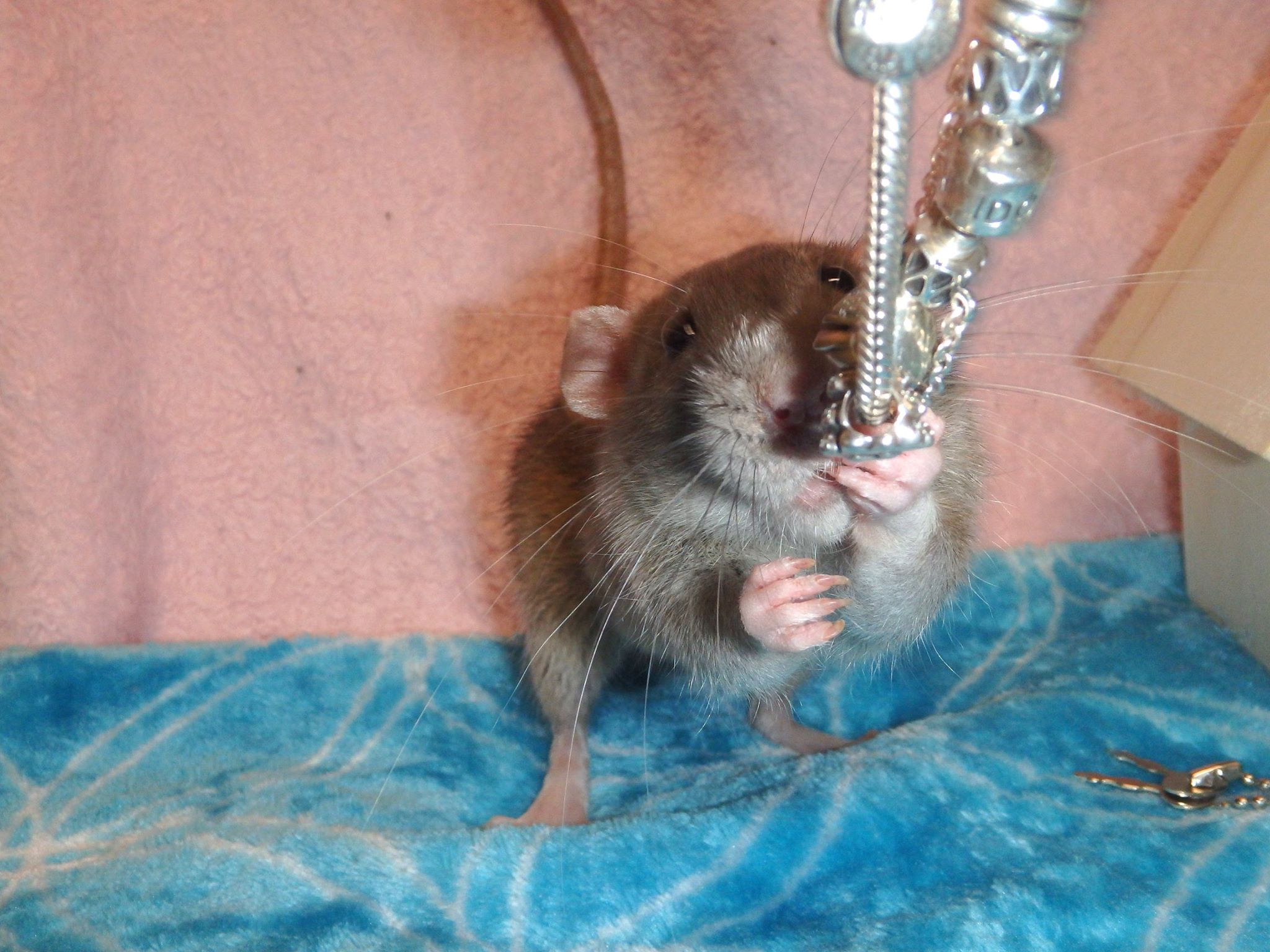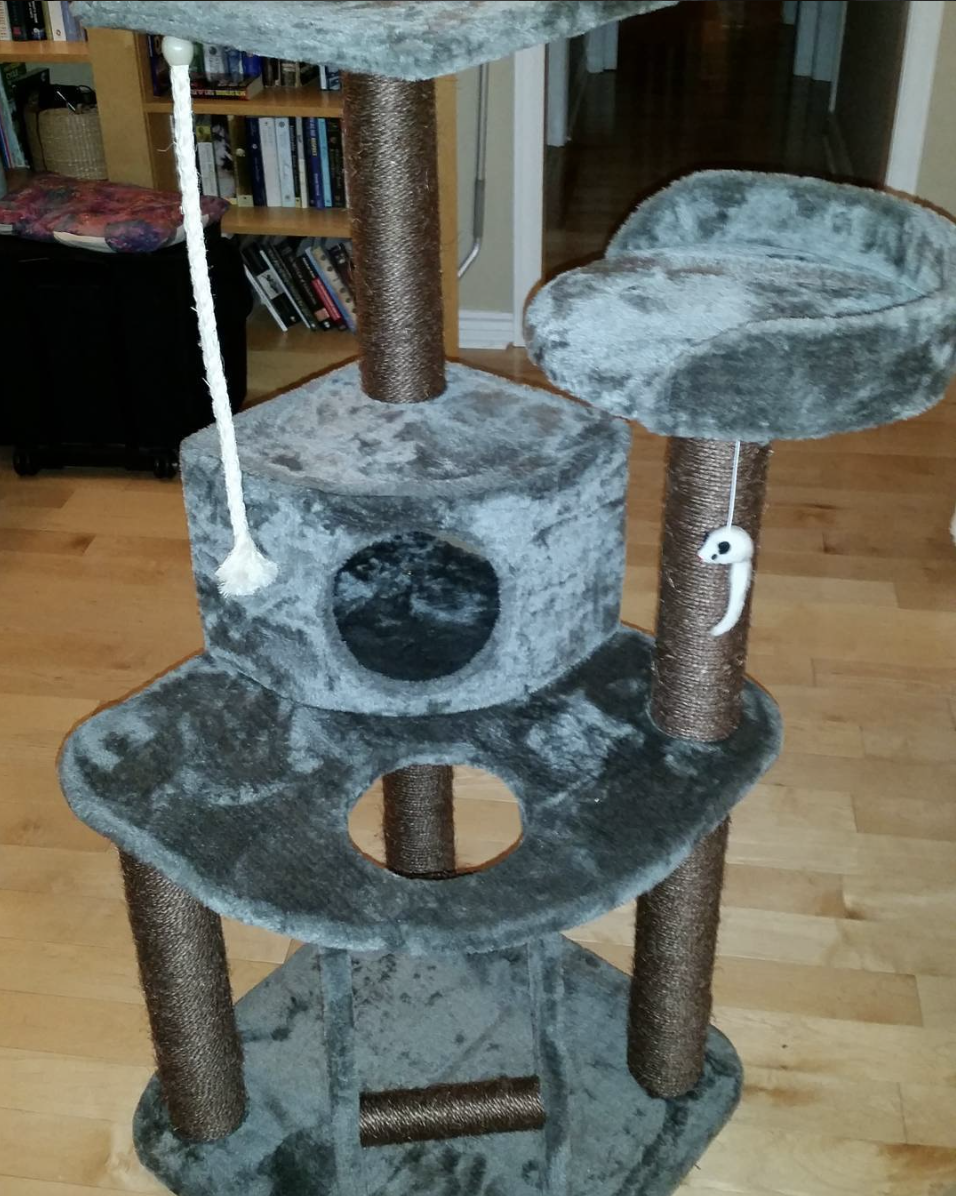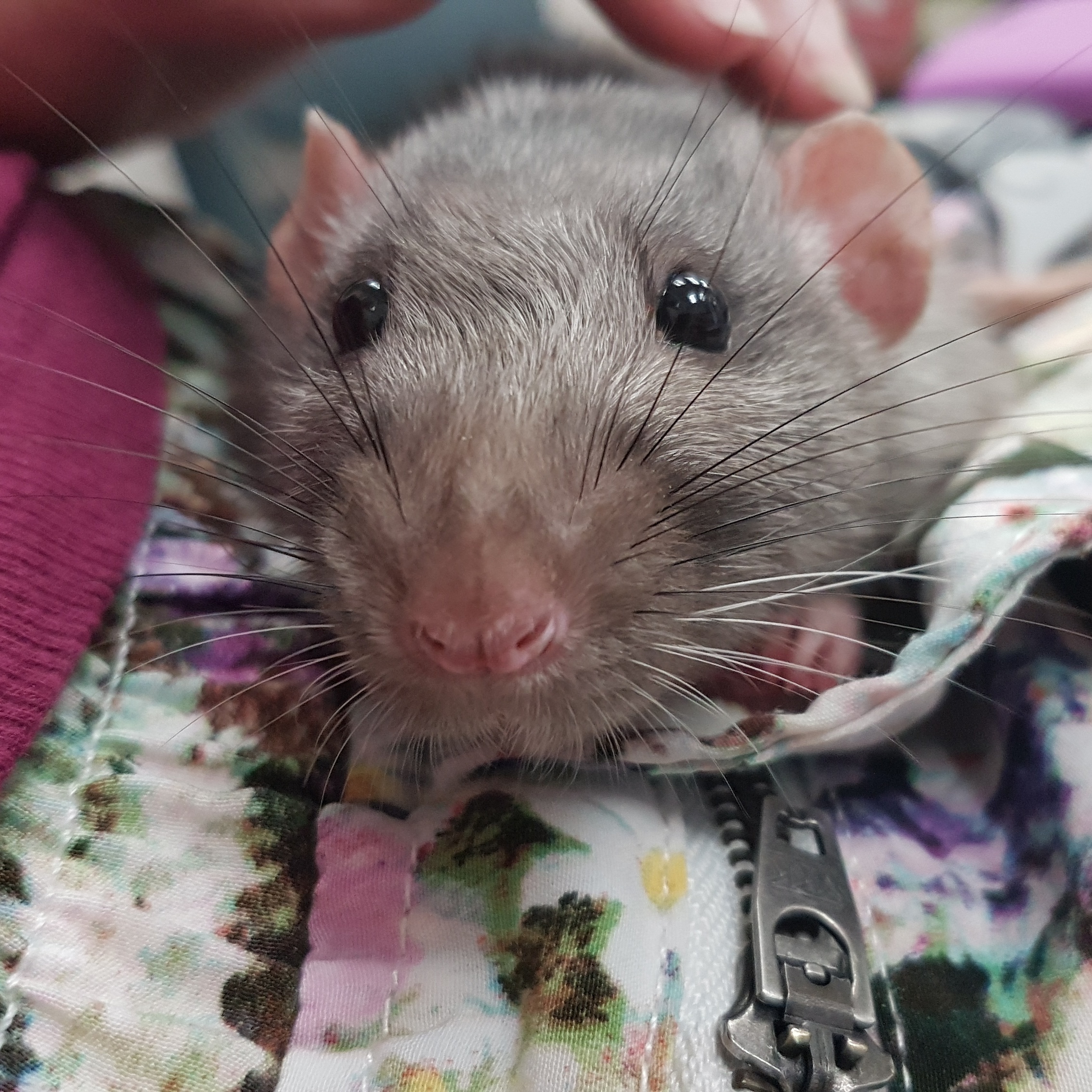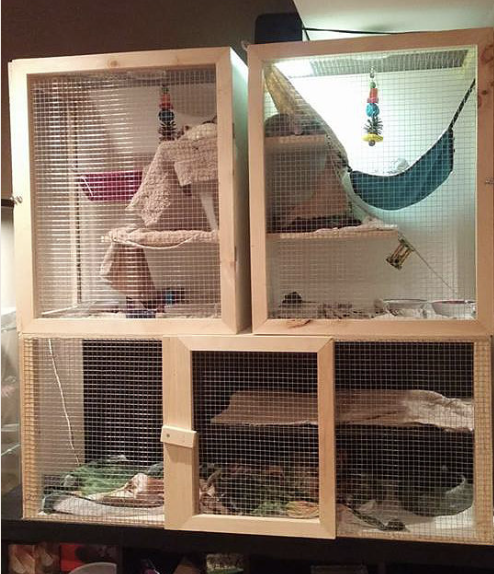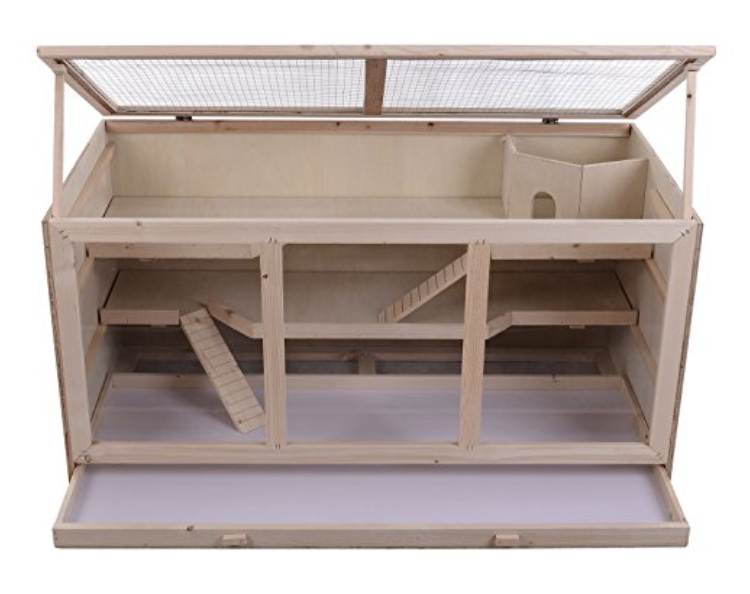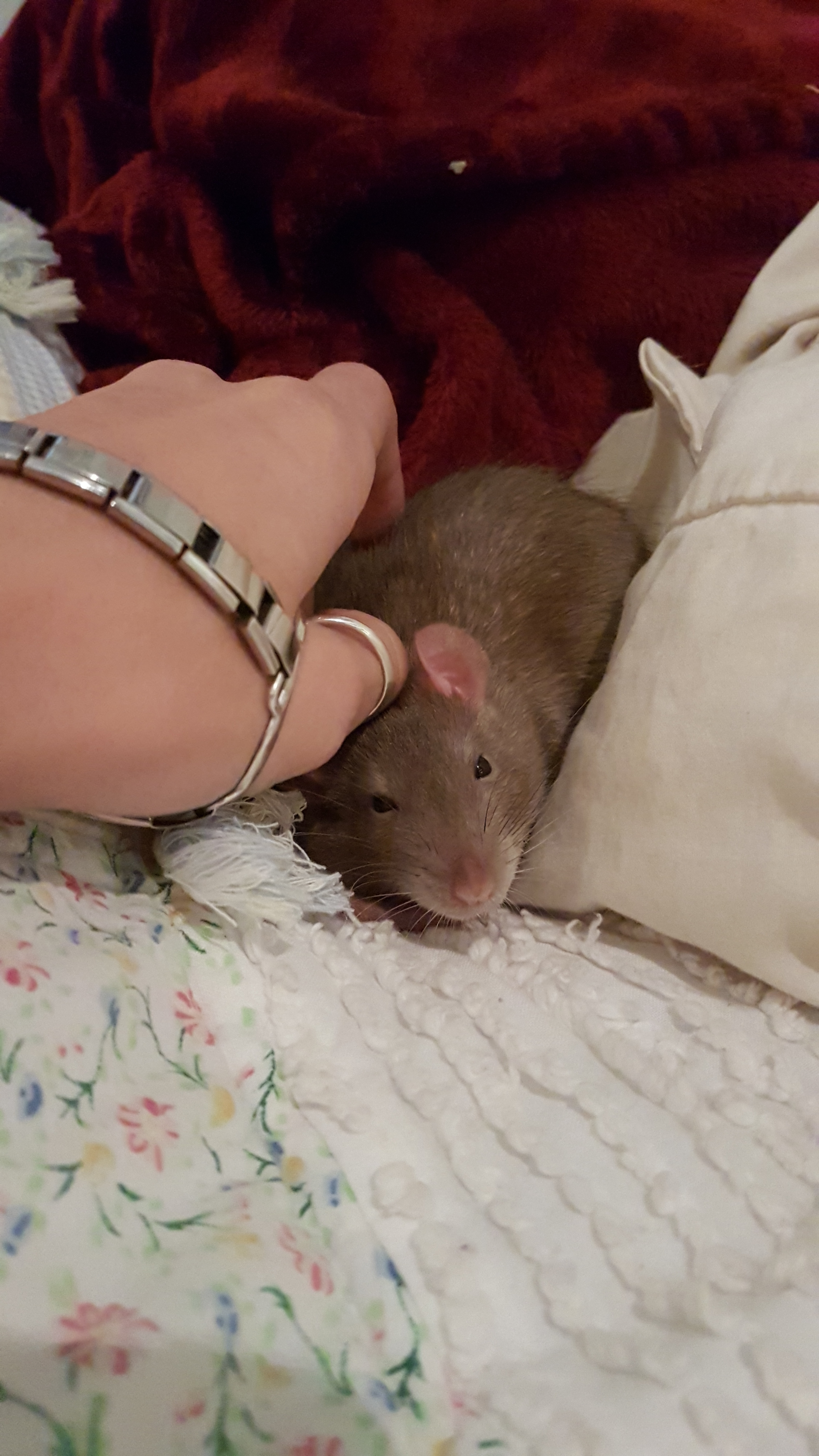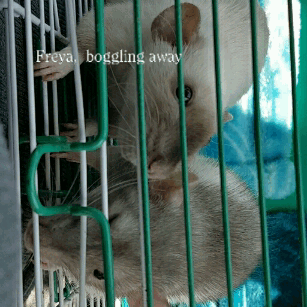Follow the links below to find more information on the topic.
The Rat Emporium is not currently an active rattery. The website remains up for informational purposes, and I am happy to answer any rat related questions no matter where you adopt! Active shelters and ratteries (as of Jan. 30/2023) are listed on my contact page.
You can click on your interest or just scroll down to go through all topics.
This page is a collection of all the information I learned in 3 years of selective pet breeding, talking to other breeders, vets and pet owners and researching online. I did my best to make it as easy to read as possible; it looks like an intimidating amount of information but is concise and coupled with a bunch of cute pics of some of my ratties over the years. Hope it helps make your time as a rattie parent much easier!
The following page has also been re-organized for the first time adopter with a step by step guide to preparing yourself and your home for pet rats:
FOR THE FIRST TIME ADOPTER
Click one of the blue links below to jump to that specific topic.
18. Where/how do I pet my rat?
19. How do I know when my rat is upset? / When my rat is territorial
20. Common rat terms
21. Why is my rat chewing on the cage bars?
22. Giving your rats baths
23. Playing with your rat
24. Examples of rat toys
25. Rats as Classroom Pets
26. NEVER CUT or otherwise ALTER YOUR RAT'S WHISKERS!
27. Cleaning/Trimming/Dying your rats fur
28. Taking your rats home
29. Where should I adopt a rat/why should I adopt from Rat Emporium TO?
30. Rat Health: Respiratory Illness, Porphyrin, Mites, Lice, Skin Issues, Inner Ear Infection, Bumblefoot, External Injury, Abscesses and Cysts, Tumours
30.1 - Spaying and Neutering Rats
31. First Aid Kit
32. Foods to avoid
33. Safe and Unsafe Woods for Rats
1. More than one or you keep none.
2. Rats Vs. Other Pets
3. Will my Rat like me less if it has a friend to love instead?
4. Do litter mates/siblings get along better than rats that are not siblings?
5. Differences between males and females
5.5 - Differences between dumbo and standard rats
6. Rats as cuddly pets / Lap-rats
7. Adopting older rats vs. adopting younger rats
8. Nail Clipping
9. Introducing New Rats
10. Basic Rat Training & Tricks - litter training and more
11. What to feed your rats
12. How often should I feed my rat? / Why does my rat hide their food?
13. Habitat Requirements - bedding recommendations
14. My Favourite Cages for Rats in Toronto
15. Introducing Rats to Cats (and other pets)
16. My rat is making noises, are they communicating with me?
17. How do I know if my rat likes me?
MORE THAN ONE OR YOU KEEP NONE
RATS MUST BE KEPT IN PAIRS OR GROUPS OF 2 OR MORE.
Without another little furry friend the vast majority of rats (it would be rare to find a rat that would like to be kept alone) will become very lonely and can become very sick from axiety and depression.
Human friends and attention can BY NO MEANS replace the attention and friendship of another rat. A common comparison to explain would be to imagine a human suddenly re-homed into a family of dogs. Though they may at first be happy, after a long time of not seeing any more people they would likely become very lonely and want human company yet again.
In addition, taking care of two rats will be no more work than taking care of one, I can assure you! They will play with each other, keep each other clean so they do not need to be bathed often, and will organize their cage together. They will be more friendly towards people and more outgoing, more happy and adventurous!
Rats vs. other pets
FRIENDLY, SOCIAL, TRAINABLE, CUDDLY, PLAYFUL PETS.
Rats, in contrast to other rodents, are extremely friendly and social.
They are very interactive and are closer to cats or dogs in attitude than mice or hamsters.
They show a lot of affection and are easily trained!
They love to ride on shoulders, cuddle and give kisses.
They are larger than mice or hamsters and need much more space for activity.
Those are just a few differences that came to mind! More will be explained in other parts of the FAQ. I often describe rats as small puppies. They are playful and excitable and responsible enough to free range. They require exercise to tire them out and then they’ll crawl into your lap for nap time.
Will my rat like me less if it has a friend to love instead?
ABSOLUTELY NOT!
These two girls, Axel and Beans, always curl up in my lap together. They are the best of friends and always make sure to keep me company and give me lots of love.
Your rat will be more friendly and outgoing towards you if it has another rattie friend, a rattie friend will not stop the bonding process at all but instead will help it along and double the fun.
Rats all need rat companions to keep them happy, confident, clean and healthy!
Unless neutered or spayed, rats must be kept with their own sex in any situation or they will breed. Even siblings will mate so be sure that you keep all males or all females or be prepared to have them professionally neutered/spayed before putting them together!
Do litter mates/siblings get along better than rats that are not siblings?
RAT RELATIONSHIPS AND BONDS CAN BE JUST AS STRONG WITH RATS THAT AREN'T THEIR SIBLINGS AS WITH RATS THAT ARE.
If the rats you are adopting are not siblings and have not been introduced to each other previously, take the steps listed below for introductions. All rats from the Rat Emporium should not have trouble with any introductions unless stated previously. If you are adopting rats from separate litters they will be introduced before they come home with you to be sure that they get along perfectly before they leave.
In this video you can see 12 of my girls, only 2 of them sisters, all exploring my room!
Differences between males and females
THERE ARE NO PERSONALITY DIFFERENCES BETWEEN MALES AND FEMALES.
A video of both boys and girls from my rattery!
In my observations the differences are as follows:
- Males grow to be much larger than females.
- Males develop "male parts" (obviously)
That is all. Size difference.
- Both males and females mark their territory. Whether this is more or less often depends on the rat.
- Both males and females are equally as friendly and both genders give kisses!
On the right you can see Daze, my BE marten dumbo velveteen girl. She is the laziest rat I have ever had in my rattery!
The most common assumption that I see online is that females are more excited and friendly and males are more reserved and cuddly. In my rattery and in most ratteries this is not true. The friendliness and cuddliness of a rat will depend on their genetic background. Different lines will have different personalities.
Dumbo rats vs standard rats
Common myth: dumbo rats are friendlier than standard rats.
This myth has no truth to it.There are NO differences between dumbo rats, standard rats, rex rats, siamese rats, black rats, dwarf rats, etc. Dumbo ears, rex fur, or colour of the rat have nothing to do with their personalities, temperaments or health. This being said, there ARE often differences between a breeder's different lines. One line may be more cuddly, one line may be more playful. If you are looking for a rat that will be prone to a certain temperament, ask the breeder which line/pairing/rat has those qualities that you are looking for.
My standard eared rat Crisp! His ears are smaller and placed higher on his head.
My dumbo eared rat Truffle! His ears are wider and lower on his head.
These two boys are pictured because, despite their differences in appearance, they actually are both very alike in personality. Both boys are adventurous at playtime but very cuddly when picked up and pet.
Rats as cuddly pets / Lap-rats
EVERY RAT CAN BE A LAP RAT
Like any other pet sometimes they need to get out all their energy before settling down on your lap. If you compare them to a dog, a dog may jump around and be excitable until you take them for a walk, but after they go for a walk they may calm down and cuddle up. This is the same for rats! A rat may be excitable and energetic at first, but after having some time to run around in your room, on the couch, etc. and after having some playtime with you they will calm down and cuddle up. Be patient!
Things you can do to entertain your rats and get all their energy out:
With exercise and entertainment, your rats will tire out and be ready for cuddles in no time.
Adopting older rats vs. adopting younger rats
When choosing your first rat, age is a huge factor and I would like to put down pros and cons of adopting older rats vs. adopting younger rats.
Older silvermane dumbo rat
OLDER RATS:
Pros:
- Your breeder will already be able to tell you a bit about their personality which is more developed at this time.
- They will likely be more calm and less reckless when out for playtime.
- They will be better with children (no test nibbles, no fast movements, size is better for kids)
- Older rats that you will find available at the Rat Emporium were the rats that I selected for breeders because they have good health history and the best temperament of their litter. These are the “best of the best” so to speak.
Cons:
- These rats will be older.
Younger silvermane rat
YOUNGER RATS:
Pros:
- CUUUUUTE
- Lots of time to bond with your baby and more time to spend with them as they grow.
- Bouncier, more playful (usually) and very curious. - You will see their personalities grow and develop.
Cons:
- Their personalities are not fully formed when they are babies. I will not be able to tell you 100% what kind of personality they have as their personalities are still developing and changing with age.
- They are very excitable and more skittish. They go through their “terrible twos” at around 2 months when they are a bit more jumpy and unpredictable. This is not to say they will not be friendly, they will still kiss and cuddle and explore and be lovable!! They are just more high energy.
If you are looking for cuddly pet rats, older rats may be the pet for you in contrast to younger rats. If you are looking for playful, excitable pets, younger rats may be more suited to you.
Nail Clipping
Your rats will keep their nails at a length that they prefer by nibbling on them. However, even though the length is great for them, sometimes their nails can be agitating for their caregivers. In the case that your skin is agitated by your ratties' nails I would first recommend wearing a sweater or a long sleeved shirt. Secondly I would recommend purchasing lava ledges from a pet store. These can help file your rats' nails when they walk over them. If they are still agitating you I would recommend visiting a vet to have their nails clipped as this is the safest manner. Rats are wiggly little buggers and it is easy to make a mistake while clipping their nails. If you must clip them at home please exercise utmost caution and weigh the pros and cons. Have a friend help you out to help keep your rattie still while their nails are being clipped. Be patient and extremely careful! Small pet nail clippers can be found at the majority of pet stores.
Introducing New Rats
For a more detailed step by step guide to introductions, please click here.
Hooray! You have a new pet rat, but you also have one at home! After being sure that they’re the same gender, also be sure that you have enough space for them. If your rat at home is significantly larger or older, you’re going to have to test the waters instead of introducing them and keeping them in the same cage right away. Some rats are very open to new friends and roommates while occasionally some are very territorial and aggressive. More often, it’s the males that are slightly more territorial. A territorial rat will generally try to “mark his territory" more often than the average rat. As the rat you already have has recognized his or her cage as its “home”, they may become protective of the area. To minimize conflict, you’ll want to first introduce the rats outside of the cage. Keeping a hand on your original pet will help it to calm down a little bit. New rats will not always get along right away and may need to establish a hierarchy to live under. This means the rats will need to wrestle it out, and determine who the “alpha” will be. The winning rat generally will establish its victory by digging its nose into the other rats belly or neck. The wrestling may go on for over a day and you may hear a few squeaks but that is all normal. Stop them only if blood is drawn, in which case you may need to reconsider giving your more aggressive rat new friends at that time. If you are alarmed by the amount that they are wrestling, keep them in separate cages for a while and take them out to introduce them to each other until they are calm.Once your rats are fairly comfortable with each other, your next step to moving them in together is going to be cleaning out the cage. Cleaning the cage eliminates any odours that define the cage as “territory” of one of the rats and leaves it as a blank canvas for them to live in together. Ensuring that there is always enough food and water available to your rats is going to be crucial as extreme starvation or dehydration can cause them to fight, become more aggressive or even cause cannibalism. Baby rats are very easy to introduce and you should have no problem introducing two young rats. Older rats, especially males or females who have already had a litter, are more territorial and one should be wary and present when introducing them. If you are adopting a new female rat from a pet store or any other placed where they may have been with males past 4 weeks it is crucial to make sure that the new female is not pregnant. Pregnant females are sometimes particularly agressive and will often viciously attack other female rats. Pregnant rats will have a wider belly and gain weight on their sides in addition to underneath. If you are unsure if your new rat is pregnant or not, quarantine her for 2-3 weeks before introducing the new rat to your existent rattie family to make sure that she is not.
Question your breeder about territorial tendencies in their rats.
Basic Rat Training & Tricks
Rats can very easily be trained to recognize their names and different sounds. To teach your rat tricks, begin with picking a distinct clicking noise. Each time you give your rat a treat, make this clicking noise so they relate the sound with the food. After a bit of work, your rat will respond to the clicking noise the way a cat or dog will react to shaking a treat bag.
LITTER TRAINING
Fortunately for you, rats are among the easiest pets to litter train. All you’ll need is a small animal litter pan and a different type of bedding/litter than you already have in your rats home. Your rats will generally choose one particular corner of their abode to “do their business”. Simply place your litter box filled with a litter/bedding in this corner. Now change the main bedding or fleece (or other rat safe fabric that won't catch their claws) in the cage, and take some of the feces from the previous dirty bedding and place it into your new litter box. It may take a while, but your smart little rat will quickly recognize this as his new "bathroom". Rats will also learn to “hold it” while you take them out to play.The main problem I have with some rats and litter training is some ratties like to throw the litter bedding all over the place. My solution to this is to either cover the litterbox with another fleece (or other rat safe fabric that won't catch their claws) and hold it in place with binder clips or to simply leave the litterbox empty. Using the same method as before your rats will still learn to use the litterbox, if they will cooperate however it will be less smelly if they will leave a litter/bedding material in the litterbox. For my rats that have an empty litterbox they still use it very well, I just change it more often to maintain cleanliness.
TO NAME TRAIN
Call your rat’s name. If they respond, give them a treat and make the clicking noise. Be sure to change the clicking noises for each rat that you own to avoid confusion.
TO TRAIN YOUR RAT TO JUMP INTO YOUR HAND
Hold your hand with a treat in your palm increasingly higher off the floor. Give them a separate command that indicates that you want them to jump up. When they retrieve the treat, make the clicking noise. Start at a relatively low height to prevent injury. These are basic tricks your rats can learn, and the two methods can be used (distinct words, clicking noises, and treats in the proper location and time) for almost every trick such as returning to their habitat on their own and walking on their two back legs. For treats, use anything other than their ordinary food that you do not often gift to them. Different rats will prefer different treats. Examples include various fruits and nuts, seeds, and possibly yogurt treats (though some rats could be allergic so use caution).
TEACHING YOUR RAT NOT TO NIBBLE ON YOUR FINGERS
If you find that your baby gets curious about eating your fingers or toes, simply close its mouth very very lightly and squeak loudly so that it knows that it’s hurt you. Your pet rat loves you and absolutely does not want to cause you pain, the squeak will immediately tell the rat that it has hurt you and he will quickly learn not to do it again.
What to feed your rats
Keep your rats on a lab block diet to begin with! In Toronto the best and most popular lab block foods available are Oxbow (baby and adult rat), Mazuri and Harlan Teklad. These should be available to your rats at all times and have the proper nutrient balance that your rats need. Seed diets are not healthy for rats and seeds should be saved to be used as treats for your rats. Feed your rats a pinch of your every meal unless it contains the ingredients listed below in the food section! Adding veggies and fruits to their diets daily can be extremely beneficial. Broccoli, red grapes, peas, carrots, peppers and other vegetables (many lists found online) are great for preventing illness and cancer.
MAZURI RAT FOOD - LAB BLOCK
Mazuri lab blocks have a fantastic balance of ingredients and are a great staple diet for your rats. These lab blocks can, and should, be kept in the cage at all times so rats can eat when they desire. Mazuri blocks are most often sold in bulk online, but can also be purchased from the Rat Emporium for $20/5lbs.
OXBOW RAT FOOD- LAB BLOCK
Oxbow lab blocks are the store bought equivalent to Mazuri lab blocks. They are a great staple diet for your rats and can, and should, be kept in the cage at all times so rats can eat when they desire. Oxbow blocks can be found in almost every pet store and cost 25.82$/5lbs.
FRUITS AND VEGGIES
Vegetables, fruits and other foods from your table should be fed to your rats daily to keep them healthy! Giving your rat an enriched diet can really improve their health and lifespan. A list of foods that are safe and unsafe for rats can be seen here.
How often should I feed my rat? / Why does my rat hide their food?
Keep pellet food available for your rats at all times. They may take their food out of the dish and hide it or just eat it from the dish, but refill the dish each time you find it empty unless you see that they have a big store of food hidden and available. Rats with regulate their own diet and choose their own eating hours and will not overeat. If they are becoming obese this is not because they are overeating, but because there is too much fat in their diet which can be managed by looking into different food types. You may also feed your rat out of your own fridge and parts of the meals you eat yourself, save for the foods mentioned that they should not eat. Your rat may hide their food because rats like to organize their own things! They are just putting their food where they want it. This cannot be trained out, just let your little babies put their food where they wish!
Habitat Requirements
- Have a cage size minimum of 2 cubic feet per rat.- Use fleece bedding (or other rat safe fabric that won't catch their claws), paper bedding or aspen bedding, other bedding may cause respiratory infections. For a litter box, rodent litter is available at almost all pet stores.
- No scents in the room, including scented candles, air fresheners, scented bedding or litter etc.
- It is recommended to clean the cage every week or more often if possible to keep them in a sanitary environment. A dirty cage can cause bad odour, a dirty coat and tail, and illness.
- Small animal chew toys including wooden structures, and antler medallions to strengthen teeth and keep them healthy.
- No barred floors unless covered in another stable material, because stepping on the bars causes “Bumble Foot” which causes them extreme pain and discomfort
- A rat friend to cuddle, sleep and play with!
- Have fresh water and food available at all times for the rats to snack on. Rats are most likely to cause conflict among themselves if dehydrated or hungry. They will regulate their food intake on their own and likely will not over eat. Rat obesity can be avoided by regular playtime outside of the cage.
- No hamster wheels or balls inside or out! Rats are one of the largest rodents you can have as a pet, and a majority of the exercise apparatuses available in pet stores are too small and can cause spinal injuries. Wheels with bars can catch their tails and cause further injury! If you are looking for a wheel, a flat spinner or plastic 12" wheel with no holes are your best options!
- Try to avoid any sort of extreme temperature changes in the room that your rats are kept in to reduce chance of illness.
To clean your cages:
Use hot water and white vinegar. White vinegar is a fantastic disinfectant and will leave your cages smell free. Put a bit of white vinegar in your laundry load if you are using fleece (or other rat safe fabric that won't catch their claws)to help remove any scent from your fabric as well.
There are a ton of "recommended" cleaners at pet stores, as well as wipes not only for your cage but also for your pet. These cage cleansers are not nearly as effective as water and vinegar and will leave a scent after you clean, and those that are recommended for being used on your pet are unsafe for rats.
If you are using dish soap and water, eventually a rattie smell will build up and that in combination with the smell of dish soap isn't the most pleasant! Overall vinegar and water works best!
Bedding comparisons
Area, environment and availability all influence what type of bedding is best.
Rat safe fabric - my first choice.
- Make sure you use a material that cannot catch any rattie toes such as fleece.
- Can be used in bar cages
- Daily spot cleaning and scoops are easy
- Ammonia buildup is faster so fabric must be changed more often
- Vinegar added to a laundry load helps to better clean fabric
- No dust, no mites upon purchase
- Occasionally rats can be allergic to detergents so sometimes detergents must be changed to accommodate (I have never experienced this myself)
- Easy litter box training
- More cost effective as fabric can be re-used multiple times (This is true in comparison to store bought bedding. Bulk bedding may be cheaper or similarly cost effective ultimately when
bought in bulk.)
- Pretty!! :D
- Does not have an original smell
Aspen - my second choice.
- Can be used in bin cages. Can be used in barred cages if additions are purchased. I personally find aspen more messy as rats can have “bedding parties”.
- Daily spot cleaning can be done, more material must be removed in spot cleans.
- Ammonia build up takes longer. When doing a full clean, unused spots of aspen can be recycled.
- Dust is present though minimal however when opening a bag check that dust is not excessive. Mites occasionally arrive in bags of aspen so be sure to check for mites when opening a
bag. I would recommend freezing every bag purchased before use.
- Cost effective when bought in bulk.
- Smells nice though I do know some can be allergic to the smell. Does not smell too strongly.
With further experience, carefresh has been taken off of the list. carefresh and paper beddings continue to cause respiratory irritation, which ceases upon removal of the bedding.
- This conclusion has been made after many people have messaged me addressing this.
If you are looking to use a bedding unlisted here, please message to confirm that your bedding is suitable.
Pine : I do not recommend pine as a bedding as I have found pine bedding in Toronto is not properly kiln dried. If your pine bedding has a pine scent to it, it is unsafe for rats. All pine beddings in Toronto have this scent and have therefor been deemed unsafe. Please take the route of caution and use other bedding for your rats.
My Favourite Cages for Rats in Toronto
#1 - DOUBLE CRITTER NATION/ALL LIVING THINGS MULTI-LEVEL SMALL ANIMAL CAGE (available on amazon and in pet stores - $$$)
This is my personal favourite.
Pros:
- Easy to clean. 30 minute clean time estimate with fabric.
- Easy to hang hammocks/cage accessories over all levels.
- Levels work well with fabric- large binder clips fit over levels.
- Tons of space!!! A DCN can fit up to 8 ladies and 6 boys. Lots of space to climb around.
Cons:
- Does not work well with bedding other than fabric. Pans are shallow and bedding falls through the bars. Deeper pans can be ordered online.
-Bars must be deep cleaned. A spray bottle with vinegar and water, steel wool, a cloth, a toothbrush and a toothpick are your best tools for doing an in-between-the-bars deep clean.
SINGLE CRITTER NATION/SINGLE LEVEL ALL LIVING THINGS MULTI-LEVEL SMALL ANIMAL CAGE :
Pros and cons are the same as the double critter nation cage but of course the space is halved. All the same perks, half the space. Great for 4 females, 2-3 males.)
#2 - Custom cages
Pros:
- Absolutely beautiful cages. The most beautiful cages I have ever seen in my life.
- Great amount of space. With customization, these cages will be able to fit as many rats as you desire as you can have a cage built to any size.
- Can be built to fit any space in the house.
- Easy to clean with facrib bedding.
- Good for hanging hammocks
- Bar spacing suitable for rats of all ages.
Cons:
- Some designs would not work well with aspen or paper bedding, but this is customizable so you can always ask for a cage with elevated sides.
- I personally find mesh harder to clean than straight bars.
- I personally prefer having removable levels, these levels are fixed and do not have removable trays.
#3 - for adult rats only - WARE INDOOR 4 LEVEL HUTCH SMALL ANIMAL CAGE (found on amazon and in pet stores - $$$)
Pros:
- Great amount of space. Can home up to 6 girls or 4 boys. Lots of space to climb around.
- Works well with bedding bottom and fabric on shelves.
- Pretty good for hanging hammocks.
Cons:
- DOES NOT WORK FOR BABY RATS. Bar spacing is large.
- A bit more steps to the cleaning process. Will take around 30 mins to clean fully.
- Levels are a bit more difficult to put fabric on. Would suggest attaching fabric with safety pins. Fabric cannot go on bottom pan.
- Bottom level is easier to chew apart. Be sure to keep lots of distractions on the bottom level.
#4- ALL LIVING THINGS RAT STARTER KIT (available on amazon and in pet stores)
Pros:
- Great amount of space for 2-3 rats.
- Easy to hang hammocks and baskets.
- Easy to clean- 15-20 minutes clean time.
Cons:
- Plastic bottom is easier to chew apart.
- Cannot secure fabric to bottom pan, but works well for other types of bedding.
- Bars get messy faster, would recommend doing a bar cleaning (extra 10 mins of work) every week.
There are a few other cages that I have found recently that are appropriate for rats, but I do not have experience with these cages nor have I heard any reviews for them from rat owners, so please purchase with caution. Here is one example below, I am going to make a separate page for more cage reviews and options. The new page will be up soon and a link will be posted here.
Pawhut Fir Wood Hamster Cage Mouse Rats Mice Small Animals Exercise Play House with Slide Wooden Coop Portable (available on amazon)
Overall Dimensions:
45.3"L×23.6"W×22.8"H;
Platform Size: 44.4"L×9.8"W;
Slide Size: 2.7"W×11.0"L;
Tray Size: 44.3"L×23.2"W
I would assume that this cage would be best with aspen bedding in the bottom tray and fabric on the shelves. I do not know if the shelves are removable, but if they are not it may be a bit harder to clean. Wood is often also a little bit more difficult to disinfect, but the cage looks beautiful. If anyone has experience with this cage please message me so I can update it's profile!
If you are unsure if a cage is appropriate for rats, the following is a list of things to watch out for:
- Flooring must be solid. Barred floors are unhealthy for rattie paws and can lead to bumble foot which is painful for your rat.
-Space requirements. Rats generally require 4 cubic feet of space per pair of rats (2 cubic feet per rat) and in every case, the bigger the better. Cages under 4 cubic feet are inappropriate for rats.
- Walls should be barred. Tanks are not appropriate living spaces for rats unless used solely for quarantine or a very short adjustment period. Hamster cages, guinea pig cages or rabbit cages are not suitable living quarters for full grown rats.
Introducing Rats to Cats (and other pets)
IT IS NOT RECOMMENDED TO INTRODUCE YOUR RATS TO OTHER PETS
It is the best idea to never introduce the two, instinctually rats are prey to cats and introducing them can be very dangerous; cats have the instinct to attack the rats and rats have an instinct to claw at the cats whenever they are close. Though I would never recommend introducing the two and strongly discourage it, I am sure some will introduce them anyways so here are my tips on the situation. There are exceptions in which rats will get along with cats or other animals, but even with these exceptions there are tons of rules. Firstly, NEVER EVER leave the cat and the rat together alone or out of your sight. When you are introducing them, hold them both back from each other when they are sniffing each other at a safe distance. Things to look for at this time: 1. tails moving quickly/darting2. fur standing on end3. any paw swipes at each other4. sideways jumping or over-excited attitudeIf, and only if there are none of these signs, and with your hands on or close to the two animals, allow them to do a more thorough inspection of each other. If any of the signs pop up separate them immediately. If either of them are having a negative reaction or seem afraid (retreating quickly, darting eyes, using the washroom excessively, any other nervous reaction) do not leave them together any longer and hope for it to get better, separate the two immediately!If all goes well and they seem comfortable with each other, you can let the two hang out but still never leave them alone and always be in arms reach of the two. Even if they have gotten along in the past, they can suddenly change and attack each other. Even being in the same room as each other can cause a ton of stress and, rats being very sensitive and aware creatures, can cause a lot of illness in your rattie. When rats are stressed they often stop eating and drinking water and can start loosing fur and developing other stress-related illnesses (all illnesses) and that would not be worth a cute picture! One of my cats pays absolutely no attention to the rats and the majority of my rats are not affected by my cats being in the rat room and are generally very curious. I have let this cat meet one of my most confident rats before, but they did not interact they simply ignored each other!I have other rats that will become terrified around cats so I keep them at a level where they cannot see each other if the cats are in the rat room, and of course the cats are never allowed in the rat room if I am not present.So if, in the end, you find it worth it to introduce the two, start with seeing them interact if the cat is around your rats cage. Watch for all signs of agitation, and never force them to be together if anyone is scared, angry or hungry! If you are looking to introduce your rat to other pets, make sure you watch them in a similar manner and be very careful.
My rat is making noises, are they communicating with me?
NO. NEVER. EVER. NO.
Rats will not make any chirping or squeaking noises to communicate unless they are in distress. They may squeak while wrestling with friends which tells their friend that they are unhappy and would like their friend to stop, and this is normal unless it is happening excessively or they are being injured (blood drawn) in which case you should separate the two and introduce them again with caution.Another reason your rat may squeak is out of fear. My rats will never be afraid of people, but if you have a new rat from another location that squeaks when you pick them up they may be feeling in pain or be afraid of leaving their safe place. If they are afraid, coax them out with treats to get them accustomed to the area and start your socialization process with soft petting and a quiet area instead of just jumping to picking them up and playing. Other reasons for unexplained squeaking are health related. If your rat has an RI they may make squeaking/sneezing sounds in which you should start a treatment as soon as possible if it gets worse. Ratties can also get the hiccups, these should go away in a matter of minutes and is nothing to worry about.
How do I know if my rat likes me?
Your rattie will show you that they love you in many different ways depending on their personality. First there are the basics: kissing and bruxing/boggling. If your rat is licking you they are showing you affection by grooming you.
If your rattie is bruxing and boggling around you they are comfortable and happy!
Bruxing is when ratties rub their incisors together to make a grinding noise, boggling occurs when rats are bruxing so much that they move their eyes quickly in and out (which looks hilarious by the way) and both are signs of content and happiness. These can also be signs of fright when accompanied by shaking, but the former is most likely. Some ratties will be bruxing and boggling all the time, some will only do this occasionally and when they are extremely comfortable. Some ratties will kiss constantly, some will only give kisses when they find it necessary. Ratties will also show affectionate behaviour even if the first 3 signs aren't present. They will "popcorn", jumping into the air from happiness, run away and run back to you in an excited manner when they are pet and some will snuggle.
Where/how do I pet my rat?
The vast majority of rats like to be pet most behind their ears. Rubbing behind their ears is lovely! Some also like to be pet gently between the ears or with your full palm down their back. Some ratties don't like to be pet at all and some like to be pet more than others so take your time getting to know your good friend and finding their "sweet spots" where they like to be pet.
How do I know when my rat is upset? / When my rat is territorial
When your rat is upset they will squeak, stand their fur on end, hop sideways, bite or make aggressive noises when touched. If your rat is aggressive towards other rats, puffs their fur up around other rats or rubs their sides on the floor or anywhere else, these are all signs of being territorial.
Common rat terms
Bruxing- when a rattie grinds their teeth together to show happiness or anxiousness.
Boggling- when a rattie is bruxing intensely and their eyes vibrate in and out.
Popcorning- when a rattie jumps straight into the air from excitement.
Heart rat- a rattie that you have a special connection with.
Popcorning
Boggling (watch her eyes closely!)
A better video of boggling can be seen here.
Why is my rat chewing on the cage bars?
If your rat is not out and about often enough for some free range time or does not have enough toys in their cage they may start chewing on the cage bars as a sign of boredom. In the incident that you find your rattie chewing on the bars try to let them roam around for longer each day and add a few toys into their cage.
Giving your rats baths
YOUR RATS DO NOT NEED BATHS UNLESS THEY ARE INCAPABLE OF CLEANING THEMSELVES.
This can happen with age or injury. If your rat is young and healthy they will not need a bath as they can clean their whole bodies and the places they cannot clean, their friends will clean for them. Rats also have natural oils on their skin that should not be washed off if it can be helped! Before you try giving your rat a full bath, introduce them to water so they are not afraid. To introduce your rat to water in a friendly way, fill a shallow dish with lukewarm water and put it in the room where your rats are comfortable. They will likely explore the water. To tempt them to jump in, possibly put their favourite toys or some of their favourite snacks in or nearby the water. Once they are comfortable in this level of water, increase the depth and size of the dish gradually. Always make sure they have places to stand on and rest, and also a ladder to climb in and out of the water on their own. Once they are comfortable with shallow or deep water, you may bathe them with animal shampoo. Make sure they are thoroughly rinsed off and have a cozy towel ready to dry off afterwards. If your rat will not step in the water but you must bathe them (no option, must bathe) put a shallow level of lukewarm water in a bathtub or a tank. Place your rats in and clean them as fast as humanly possible. You may need a friend to help you as they can be super jumpy and squirmy when taking a bath that they do not want. Your rats can swim, but you should never EVER make them swim or put them in water that they cannot easily stand in with all four feet without having their faces submerged. If your rat does not want to swim in deep water, they should never be forced to.
Playing with your rat
Rats love to play! Even the laziest of ratties will have their little games that they like to play for fun. Take some time reading their body language when doing certain activities and you will find out strange little games that your ratties love.A few weird games that my ratties enjoy:
Couch run- Duncan loves to play couch run. This "game" is simple. I sit on one side of the couch with him in my lap. He pretends he isnt planning anything and then bolts to the other side of the couch and waits for me to bring him back to the beginning.
Chase- rats love to chase around shiny objects (necklaces, bracelets, etc) and even your hand. Smoosh- when you pet your rats face in a smoosh manner they will often run away real fast, popcorn and come back for more smooshing. This also applies to lightly scratching their back.
Beanbag jump - I put a beanbag chair on the floor near the couch. The rats will jump onto the beanbag and then wait for me to bring them back onto the couch.
Frantic Kiss Game - I kiss their faces. frantically. They popcorn around :')
Examples of rat toys
Toilet paper tubes- easy, cheap and the rats love them. They will carry and drag them around the cage, roll them around and chew on them.
Kleenex boxes- they will chew on them and drag them around or make sleeping quarters out of them! Hanging chew toys- rats will pounce on hanging chew toys and, obviously, chew them. They will find lots of entertainment from hanging chew toys and love to bat them back and forth.
Rope toys- rope toys allow your ratties to climb and give an extra special platform for them to jump around on.
Stuffed animals- they will drag them around and generally have a good time with tiny stuffed animals, just be sure to remove the "stuffed" part if they manage to pull the fluff out.
Huts- great homes and great chew toys if made of wood.
Rats as Classroom Pets
As friendly as rats are to children I would not recommend rats as a classroom pets because of their susceptibility to mites, lice, RIs and ringworm. This is not to say that a classroom would not be free of these transmittable illnesses but it is more likely that they will be transferred to rats in a classroom situation with many young people around them. Secondly, rats do need a consistent temperature and humidity to keep their respiratory systems healthy. They would probably have to be brought home overnight if the school doesn’t have consistent heating.If you are considering rats as classroom pets please be ready to maintain a higher level of caution.
NEVER CUT or otherwise ALTER YOUR RAT'S WHISKERS!
This is extremely damaging to your rat in many, many ways. They use their whiskers over 7 times per second to send important messages to their brain. they use them for vision, balance, navigation, defense, and literally to survive. Cutting or altering your rat's whiskers in any way will literally re-wire your rats' brain."Rats use their whiskers to navigate in their world, orient themselves, and balance. Whiskers help the rat find and discriminate food, court a mate, determine whether he can fit through an opening or not. At short distances rats rely more on their whiskers than on vision to perceive depth (Schiffaman 1970). Whiskers can detect wind and slight breezes too, which helps rats orient themselves underground. Whiskers are used when swimming, especially in turbulent water. Whiskers help the rat feel when its nose is above the surface. Without whiskers, the rat will drown (Ahl 1986, Biay 1993, Bugbee 1972, Carvell 1990, Guic-Robles 1989, Gustafson 1977, Vincent 1912).
Whiskers are used socially, too. During nose-offs and boxing with other rats, the defending rat attempts to keep whisker-to-whisker contact with the aggressive rat. Whiskers interfere with an attack on the head. As long as whisker-to-whisker contact is maintained, the dominant rat can't get around the whiskers to deliver a bite. However, if a rat's whisker pads are anesthetized, that rat boxes less and freezes more, and is more likely to be bitten (Blanchard et al. 1977).A rats without whiskers may be more impaired than a rat who is blind!"
Cleaning/Trimming/Dying your rats fur
Your rats do not need haircuts fortunately! Rats do not need baths either and will keep themselves and each other as clean as they should be. The exception would be a rat that cannot clean certain areas due to age or a disability that may need to be aided every once in a while with a bath. If your rat is getting excessively dirty on their fur, tails or feet it is likely that their living conditions must be changed. Your rats fur will never need to be trimmed and should not be trimmed as this could be very uncomfortable for your rat. Rats also have essential oils on their fur that should not be washed or trimmed away. If you are looking to dye your rats fur I would recommend against it. Rats will groom at their fur constantly and you wouldn't want to put anything on their fur that they cannot ingest.
Taking your rats home
Be sure to bring a carrier with a little bit of food in it for when you take your rats home from anywhere! Please do not let your rats free in your car while you are driving as they may interfere with your concentration.
When your rats arrive in your home, feel free to take them out and cuddle and play with them right away if they show confidence and start exploring the cage. Any rats adopted from the Rat Emporium should be ready to come out of the cage and spend time with you the second they arrive in their new home.
When rats arrive in a new environment you will occasionally observe some light sneezing as they adjust to the dust levels and scents of their new environment. If these sneezes do occur, they should be light and unaccompanied by any symptoms of an illness. These sneezes should disappear within a couple weeks.
Where should I adopt a rat?
It is generally recommended to buy a rat from a breeder if you are looking for a assuredly well tempered rats as breeders pay close attention to their rats personalities, behavioural traits and health and actively consider these aspects for future pairings. Professional breeders also house their rats in more humane conditions and are most often more educated in the proper care of rats. In contrast, pet stores and reptile stores' rats often come from large breeding farms where health and temperament isn't tracked and rats are paired in bulk.This brings about a greater risk of health issues and a shorter life span. They can be fantastic pets as well and can be very well tempered and some may even be in excellent health, just choose your new friend with care and of course do a thorough inspection before you take them home.
A breeder also is ready to supply you with up to date information on rat care, and is ready to answer any of your questions. In contrast, most stores offer faulty information and are not available to "chat rats".
A breeder will appreciate all information you provide on your new friends as anything you tell a breeder is put into mind for their future pairings, whereas stores do not collect information from adopters for future pairings.
If you are looking to take in and re-home a rat that is not from a breeder, be sure to look into the reason the original owners are re-homing the rat, how the rat reacts to you when it is first handled, check the gender, and make sure that your new rat is not pregnant (if you don’t want many more little critters of course).
If you cannot maintain or afford housing more than one rat, please wait to adopt.


